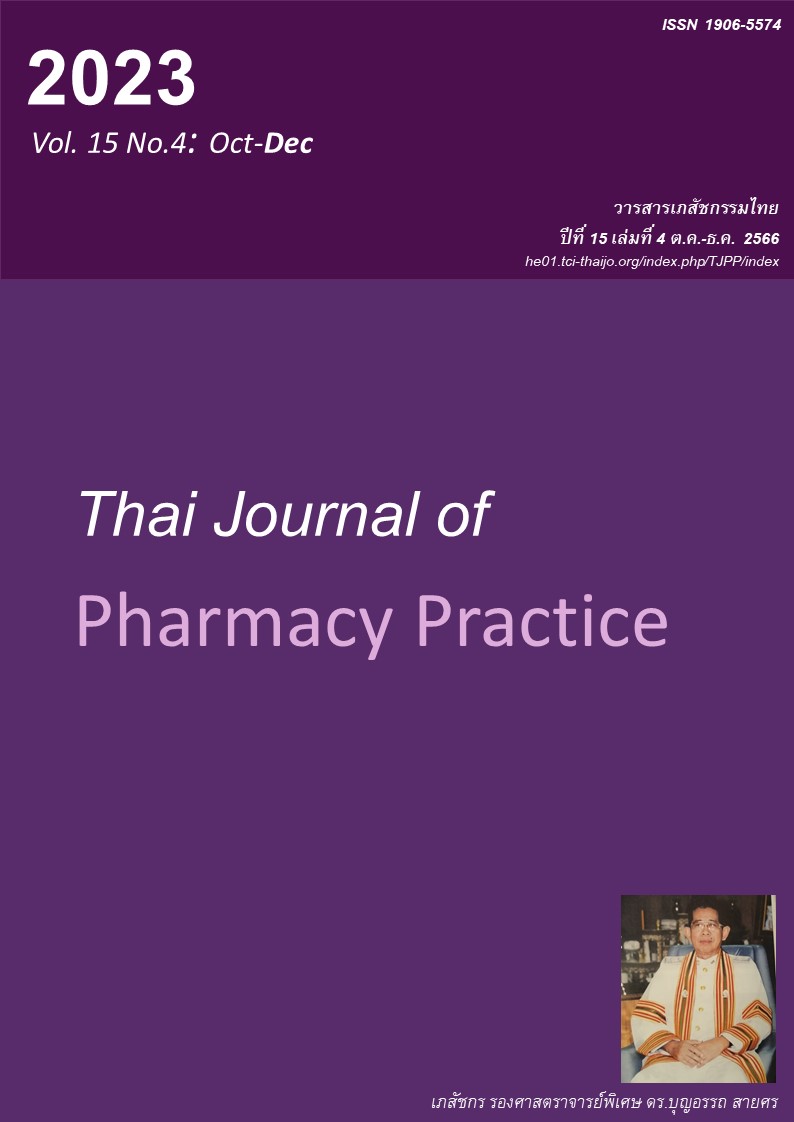ความรู้ ทัศนคติ และพฤติกรรมตามฐานวิถีชีวิตใหม่ภายใต้สถานการณ์แพร่ระบาด ของโรคติดเชื้อไวรัสโคโรนา 2019 ของคนวัยทำงานในกรุงเทพมหานคร
Main Article Content
บทคัดย่อ
วัตถุประสงค์: เพื่อศึกษาความรู้ ทัศนคติ และพฤติกรรมตามฐานวิถีชีวิตใหม่ และความสัมพันธ์ระหว่างปัจจัยส่วนบุคคล ความรู้ ทัศนคติ และพฤติกรรมตามฐานวิถีชีวิตใหม่ภายใต้สถานการณ์โควิด 19 ของคนวัยทำงานในกรุงเทพมหานคร วิธีการ: ตัวอย่างคือคนวัยทำงานที่มีอายุ 20 ถึง 60 ปีที่อาศัยอยู่ในกรุงเทพมหานคร จำนวน 400 คน กลุ่มตัวอย่างตอบแบบสอบถามออนไลน์ซึ่งประกอบด้วยคำถามเกี่ยวกับข้อมูลส่วนบุคคล ความรู้ ทัศนคติ และพฤติกรรมตามฐานวิถีชีวิตใหม่ ผลการวิจัย: ตัวอย่างมีความรู้โดยรวมอยู่ในระดับดี โดยมีค่าเฉลี่ยเท่ากับ 8.92±1.73 (จากคะแนนเต็ม 10) มีทัศนคติเกี่ยวกับฐานวิถีชีวิตใหม่โดยรวมอยู่ในระดับปานกลาง โดยค่าเฉลี่ยเท่ากับ 37.57±6.40 (จากคะแนนเต็ม 50) และมีพฤติกรรมการปฏิบัติตัวตามฐานวิถีชีวิตใหม่โดยรวมอยู่ในระดับดี ค่าเฉลี่ยเท่ากับ 24.12± 3.63 (จากคะแนนเต็ม 30) ความรู้มีความสัมพันธ์เชิงบวกอย่างมีนัยสำคัญทางสถิติกับทัศนคติและพฤติกรรมตามฐานวิถีชีวิตใหม่ (r=0.613 และ 0.614 ตามลำดับ) ทัศนคติกับพฤติกรรมมีความสัมพันธ์เชิงบวกอย่างมีนัยสำคัญทางสถิติ (r=0.563) ผู้ที่มีอายุ ระดับการศึกษา และรายได้ที่สูงกว่า มักมีความรู้ ทัศนคติ และพฤติกรรมการปฏิบัติตัวตามฐานวิถีชีวิตใหม่ที่ดีกว่าผู้ที่มีอายุ ระดับการศึกษาน้อยกว่า และรายได้ที่น้อยกว่า ผู้ที่มีประวัติใน 7 กลุ่มโรคมีความรู้ไม่แตกต่างจากผู้ที่ไม่มีประวัติดังกล่าว แต่ผู้ที่มีประวัติใน 7 กลุ่มโรคมีทัศนคติ และพฤติกรรมการปฏิบัติตัวตามฐานวิถีชีวิตใหม่ที่ดีกว่า สรุป: การศึกษาครั้งนี้แสดงให้เห็นถึงความสำคัญของการให้ความรู้เพื่อสร้างทัศนคติและพฤติกรรมการปฏิบัติตัวตามฐานวิถีชีวิตใหม่ถึงแม้ว่าจะเป็นสถานการณ์ที่ประชาชนไม่คุ้นเคย ผลการวิจัยสามารถนำไปใช้เป็นแนวทางกำหนดนโยบาย การรณรงค์และจัดกิจกรรมอบรมต่าง ๆ ให้มีประสิทธิภาพมากยิ่งขึ้น และนำไปใช้เป็นแบบจำลองของกลุ่มโรคในสถานการณ์ที่อาจจะเกิดขึ้นในอนาคตได้ ทั้งนี้เพื่อช่วยป้องกันและควบคุมการแพร่ระบาดอย่างรวดเร็วของโควิด 19 หรือกลุ่มโรคที่คล้ายคลึงกันที่อาจจะเกิดขึ้นในอนาคตได้
Article Details

อนุญาตภายใต้เงื่อนไข Creative Commons Attribution-NonCommercial-NoDerivatives 4.0 International License.
ผลการวิจัยและความคิดเห็นที่ปรากฏในบทความถือเป็นความคิดเห็นและอยู่ในความรับผิดชอบของผู้นิพนธ์ มิใช่ความเห็นหรือความรับผิดชอบของกองบรรณาธิการ หรือคณะเภสัชศาสตร์ มหาวิทยาลัยสงขลานครินทร์ ทั้งนี้ไม่รวมความผิดพลาดอันเกิดจากการพิมพ์ บทความที่ได้รับการเผยแพร่โดยวารสารเภสัชกรรมไทยถือเป็นสิทธิ์ของวารสารฯ
เอกสารอ้างอิง
Office of the Royal Thai Council. The Royal Institute defined the term “new normal” [online]. 2020 [cited Feb 20, 2021]. Available from: royalsociety.go.th/def ine-new-normal/.
Wake AD. Knowledge, attitude, practice, and associ- ated factors regarding the novel coronavirus disease 2019 (COVID-19) pandemic. Infect Drug Resist 2020 ; 13: 3817-32.
Vicerra PMM.Disparity between knowledge and practice regarding COVID-19 in Thailand: a cross-sectional study of older adults. PLoS One 2021; 16: e0259154.
Theppitak T. The KAP model and a study of behavior and attitude on prevention HIV/AIDS infection in Thai seafarers. CRRU Journal of Communication 2013; 8: 84-102.
Chaichumkhun J.Is the group of infected people really younger? On the epidemiology of COVID-19, a new wave [online]. 2021 [cited May 2, 2021]. Available from:thematter.co/science-tech/health/young-getting -infected/141799.
Policy and Planning Division. Community data statis- tics in Bangkok in 2018. Bangkok: Department of City Planning and Urban Development. 2018.
Chantawibul A, Sanugul P, Jensarikorn P, Arphacha rus N.The study of the environmental health manage ment in urban slums during COVID-19 outbreak [on line].2020 [cited Jul 27, 2021]. Available from: advi sor.anamai.moph.go.th/download/ Journal_health/2 563/HEALTH43No3/HEALTH_Vol43No3_07.pdf.
National Statistical Office Thailand. Demographic statistics population and housing: the number of populations from registration classified by age group, gender, region and province in 2020 [online]. 2020 [cited May 9, 2021]. Available from: statbbi.nso.go.t h/staticreport/page/sector/th/01.aspx
Yamane T. Statistics: An Introductory analysis. 3rd ed. New York: Harper and Row; 1973.
Bloom BS. Mastery learning. In: Block JH, editor. Mastery learning: Theory and practice. New York: Holt, Rinehart & Winston; 1971. p. 47-63.
Kijpredaborisuthi B.Research methods in social sciences. 7thed. Bangkok: Jaroenphon; 1997.
Bureau of Registration Administration, Department of the Provincial Administration. Population statistics from the civil registration [online]. 2021 [cited May 24, 2021]. Available from: stat.bora.dopa.go.th/stat/s tatnew/statMenu/newStat/stat/
Khumsaen N. Knowledge, attitudes, and preventive behaviors of COVID-19 among people living in Amphoe U-thong, Suphanburi Province. Journal of Prachomklao College of Nursing, Phetchaburi Province 2021; 4: 33-48.
Department of Older Persons, Ministry of Social Development and Human Security. Department of older persons has advice on caring for the elderly to be safe and away from Coronavirus Disease 2019 or COVID-19 for everyone [online]. 2021 [cited May 29, 2021]. Available from: www.dop.go.th/th/gallery/1 /4280.
Li S, Feng B, Liao W, Pan W. Internet use, risk awareness, and demographic characteristics associ- ated with engagement in preventive behaviors and testing: cross-sectional survey on COVID-19 in the United States. J Med Internet Res 2020 16; 22: e19782.
Department of Health, Ministry of Public Health. Group 608 is the group of people who need to be vaccinated against COVID-19 the most [online]. 2022 [cited Jan 25, 2022]. Available from: multime dia.anamai.moph.go.th/anamai-toons/covid-vaccine-4/.
Internal Medicine Center, Bumrungrad International Hospital.8 groups of patients who, if infected with COVID-19, are at risk of having severe symptoms [online]. 2020 [cited Apr 22, 2021]. Available from: www.bumrungrad.com/th/health-blog/april-2020/ covid-19-there-are-eight-risk-groups.
Internal Medicine Center, Vejthani Hospital. 8 risk groups that may have severe symptoms if infected with COVID-19 [online]. [n.d.] [cited Apr 22, 2021]. Available from: www.vejthani.com/th/2021/01/8risk groupCOVID-19.
Chen X, Chen H. Differences in preventive behavior of COVID-19 between urban and rural residents: lessons learned from a cross-sectional study in China.Int J Environ Res Public Health 2020; 17: 4437.
Zhong BL, Luo W, Li HM, Zhang QQ, Liu XG, Li WT, et al. Knowledge, attitudes, and practices towards COVID-19 among Chinese residents during the rapid rise period of the COVID-19 outbreak: a quick online cross-sectional survey.Int J Biol Sci 2020; 16: 1745–52.


